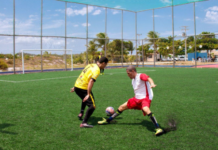Training for many different reasons can be completed and even improved through the use of aquatic performance training. This includes doing exercises and workouts within the water of a local pool to alter the resistance and lower the stress on the joints. It can be used for overall health, strength training, and for swimming or other sports training.
Why Aquatic Training is Popular
Aquatic training is popular among many demographics for the workout and health support that it provides without increasing wear and tear on the joints. The buoyancy of the water lifts the weight off of the knee joints and allows for there to be free movement of the body through the water without impact upon the joints each step that is taken. Lower impact supports healthy joints, and the resistance of moving through the water makes the muscles work harder.
Ideal for injury recovery, it is one of the best ways for people to complete training exercises in a low-impact way. Walking, running, and even jumping jacks can be done in the water and will create results faster than some other forms of training. Where running and jumping can create a harder impact on ankles, knees, and hips which can lead to misalignment, pain and straining of the muscles.
Everybody can benefit from water aerobics, resistance training, or physiotherapy in the water. Any health and fitness level can be successful with aquatic performance training and will find it a useful way to move towards their goals. It increases circulation with the water creating a massaging effect, which benefits all areas of health, from heart health to muscle healing, and when done in cool water will help to reduce swelling and inflammation as well.
How is Aquatic Training Successful
Moving physical therapy into aquatics training can improve the rate of recovery and allow people to do exercises that they would otherwise be unable to do. As the strain and discomfort is minimized, the recovery time is also decreased. Faster recovery times allow for the exercises to be completed more often, thus speeding up training.
For a successful training period, each participant goes through an assessment, including any injuries, areas that need to be worked on, goals for the process, and the options that are available for the training program. Once the details are gathered, the trainer will develop a series of exercises that will move towards the goals and that are appropriate, considering any injuries or weak areas.
As the exercises increase in difficulty and intensity, there will be continued progress. Aquatic Performance Training has more equipment than ever that is water safe, allowing for walking on treadmills, exercise bikes, weight training, and more. With massaging effect, anti-inflammatory capabilities, and the activating of the core muscles, strength is improved throughout the body and overall health from cardiovascular health to muscle strength and injury recovery, this method of training or physical therapy is an effective method for supporting the health and fitness goals of any demographic.











